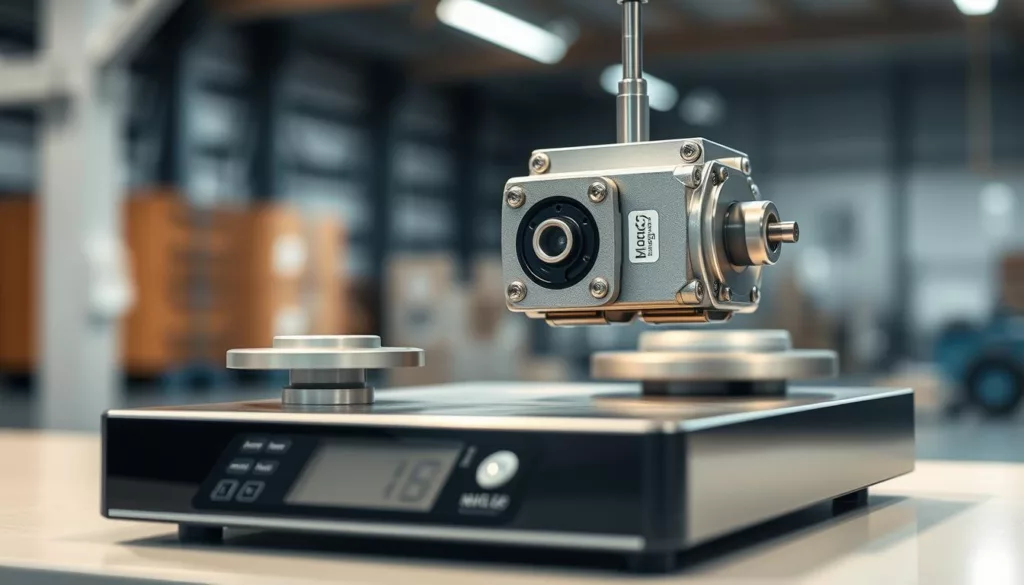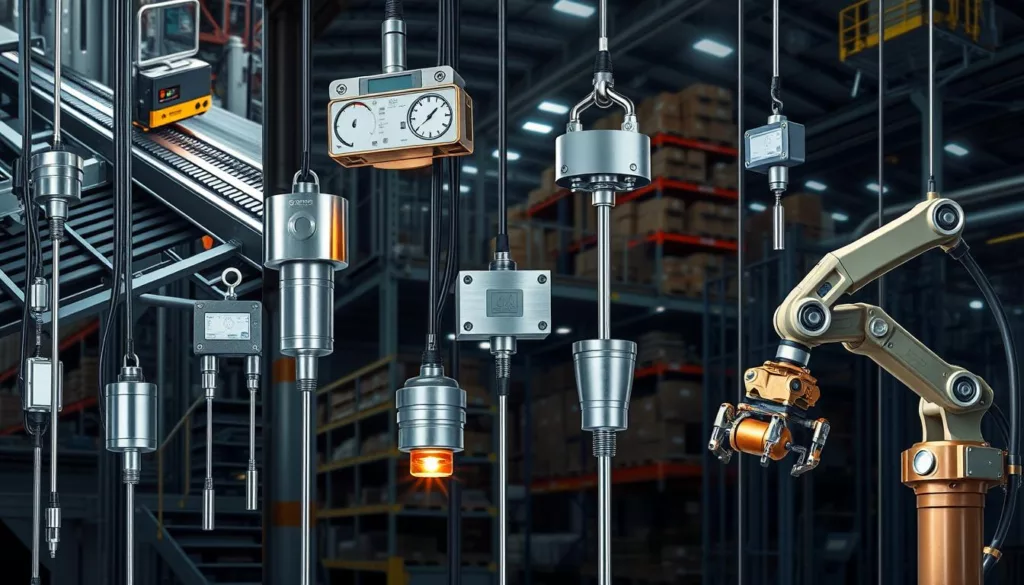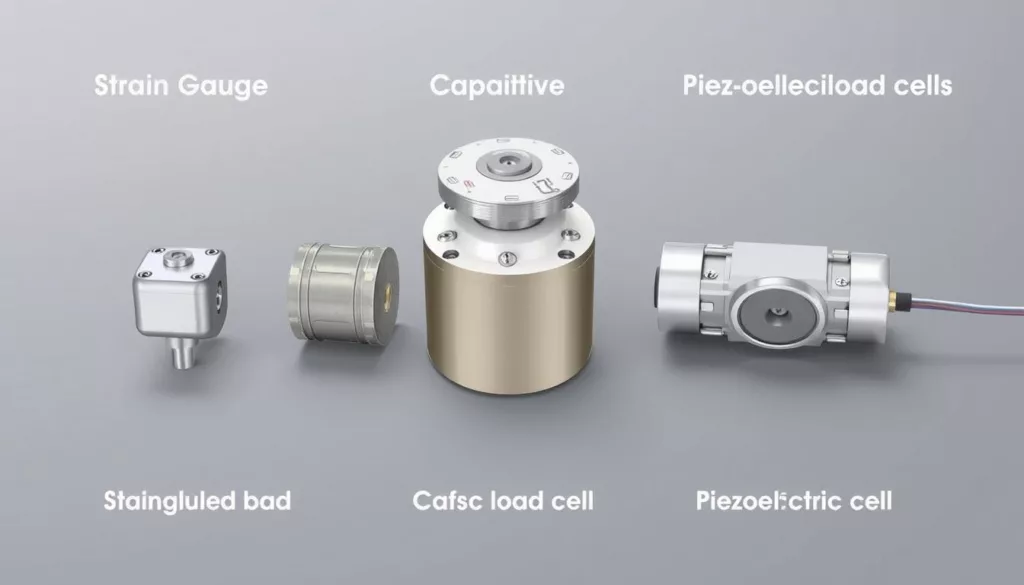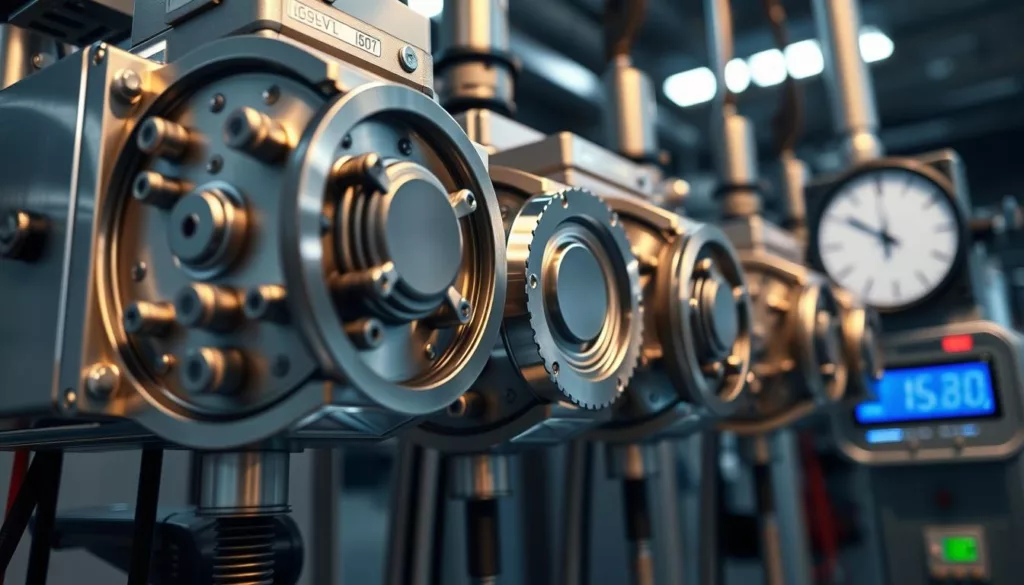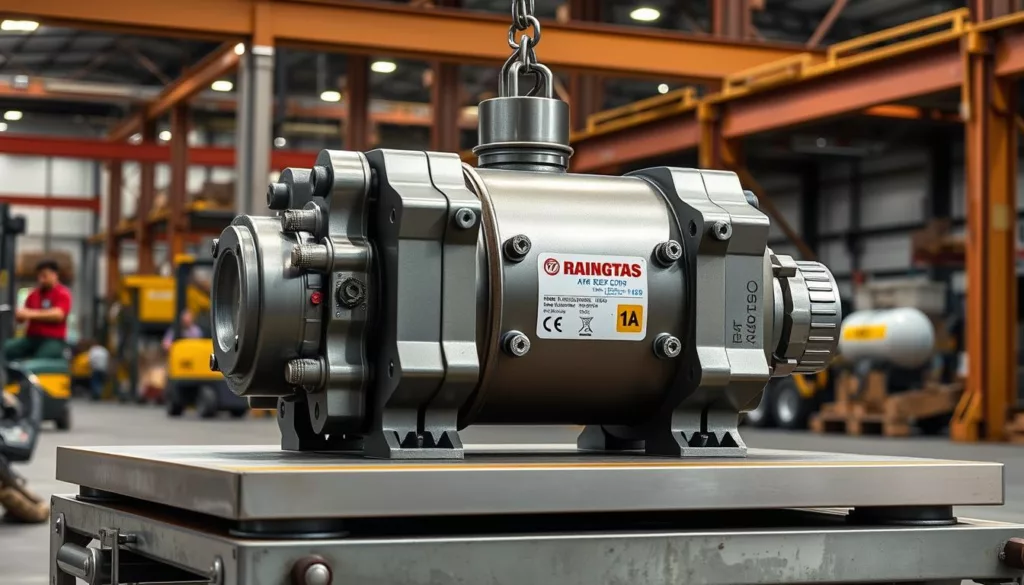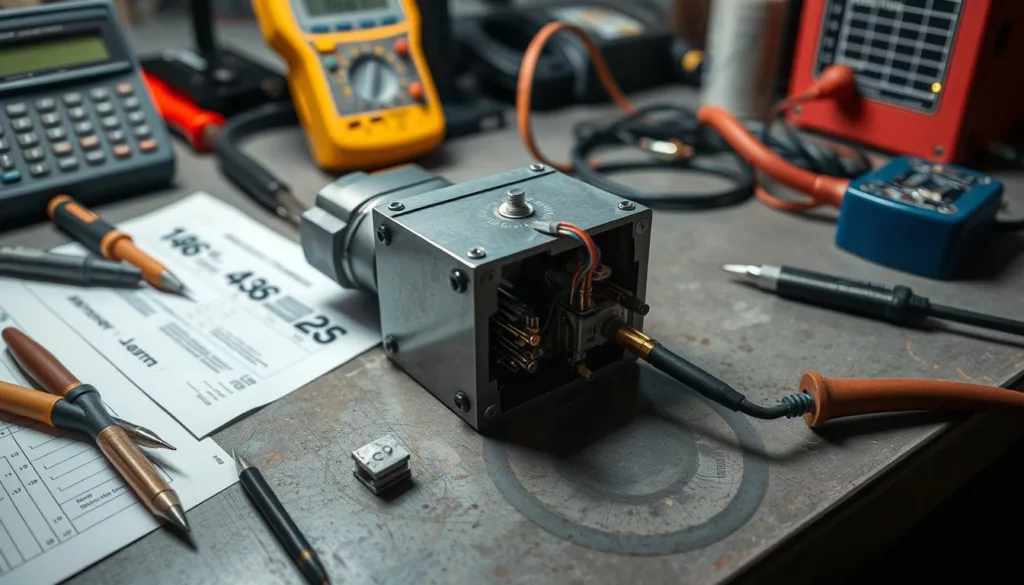Choosing the right load cell is key for accurate weight measurement. Load cells are essential in industrial weighing systems. They provide precise data for many fields, from manufacturing to healthcare. This guide will cover the best load cells available, focusing on accuracy, resolution, and capacity.
Key Takeaways
- Discover the latest advancements in load cell technology for real-time weight measurement
- Understand the importance of load cell accuracy, resolution, and capacity in specific applications
- Learn about the various types of load cells and their unique characteristics
- Gain insights into factors that influence load cell performance and durability
- Explore innovative solutions, such as wireless load cells, for seamless integration in IoT systems
Understanding Load Cells: A Complete Overview
Load cells are key for measuring weight in real-time across many industries. They are the heart of modern weighing systems. These sensors are vital for precise and reliable weight data. Let’s explore how load cell technology works and its many uses.
What is a Load Cell?
A load cell is a device that turns weight into an electrical signal. This signal is then read by a weighing device or control system. Load cells are designed for different uses and settings.
How Load Cells Work
Load cells measure strain to work. When force is applied, the cell deforms slightly. Sensitive gauges then turn this deformation into an electrical signal. The signal’s strength shows the applied force, making weight measurement precise.
Different Types of Load Cells
There are many types of load cells for various needs. Here are some common ones:
- Strain Gauge Load Cells – These are the most used for their flexibility and value.
- Hydraulic Load Cells – Good for tough environments and heavy tasks.
- Pneumatic Load Cells – Ideal for dangerous areas where electrical signals are a risk.
- Piezoelectric Load Cells – Known for high accuracy and quick response, perfect for fast weight changes.
The right load cell depends on the application’s needs. This includes accuracy, capacity, environment, and budget.
“Load cells are the unsung heroes of modern weighing systems, quietly and accurately measuring weights across a wide range of industries.”
Key Features to Consider When Choosing Load Cells
When picking load cells for weight measurement, several key features matter. These include accuracy, precision, load capacity, and temperature tolerance. Each plays a big role in getting reliable and consistent results.
Accuracy and Precision
Accuracy and precision are key in many industrial uses. Accuracy is how close the measurement is to the real weight. Precision is how consistent the measurements are. Choose load cells with high accuracy and precision for reliable data.
Load Capacity
The load capacity shows the max weight a load cell can measure accurately. It’s important to match the load cell’s capacity to your needs. This avoids overloading or underusing the sensor.
Temperature Tolerance
Load cells need to work well in your environment’s conditions. Look for ones that can handle a wide range of temperatures. This is key for outdoor or industrial settings where temperatures change a lot.
Output Signal Type
Load cells can send out different signals, like analog or digital. The right signal depends on your system’s needs and how the load cell will fit in. Think about your system’s capabilities when picking a signal type.
| Feature | Importance | Key Considerations |
|---|---|---|
| Accuracy and Precision | High | Ensure reliable weight data for critical applications |
| Load Capacity | High | Select the right capacity for your weighing needs |
| Temperature Tolerance | High | Maintain accuracy in varying environmental conditions |
| Output Signal Type | High | Choose the right interface for your control system |
By looking at these key features, you can find the best load cells for your needs. This ensures your data is accurate, reliable, and consistent.
Top Applications for Real-Time Weight Measurement
Load cells are versatile sensors used in many industries for accurate weight measurement. They are found in everything from industrial scales to medical equipment. Their ability to measure weight in real-time is truly impressive.
Industrial Weighing Systems
In the industrial world, load cell applications are key for precise weight tracking. They are used in scales, hopper scales, and conveyor belt systems. This ensures accurate product measurement and inventory tracking.
These systems are essential for quality control and improving production workflows.
Food Processing and Packaging
The food industry relies on load cell technology for tasks like ingredient weighing and package filling. They are used in mixers, feeders, and packaging machines. This ensures consistent product weight and helps meet regulatory standards.
It also helps reduce waste and optimize production.
Medical Equipment and Healthcare
In healthcare, load cells are vital for various medical devices. They are found in hospital beds, patient scales, and laboratory balances. These devices provide precise weight measurements for patient care and research.
The accuracy and reliability of these medical equipment are critical for patient safety and effective treatment.
| Industry | Load Cell Applications | Key Benefits |
|---|---|---|
| Industrial |
|
|
| Food Processing and Packaging |
|
|
| Medical and Healthcare |
|
|
Load cells are used in many areas, from industrial weighing to medical diagnostics. Companies like XJCSENSOR lead in developing precise load cell solutions. They meet the needs of these industries as they evolve.
Comparison of Load Cell Technologies
There are many ways to measure weight with load cells, each with its own benefits and drawbacks. For those in industry looking for precise weight measurements, knowing the differences is key. This includes strain gauge, hydraulic, pneumatic, and capacitive load cells.
Strain Gauge Load Cells
Strain gauge load cells are the most common. They are known for being reliable, accurate, and affordable. They turn mechanical force into an electrical signal, giving precise weight data. They work well in many places, from factories to medical settings.
Hydraulic Load Cells
Hydraulic load cells use pressurized fluid to measure force. They are famous for their load cell technology and can handle tough environments. This makes them great for heavy-duty jobs like mining and construction.
Pneumatic Load Cells
Pneumatic load cells use compressed air to measure force. They are a good choice for places where sparks or explosions are a risk. This includes the chemical and petrochemical industries.
Capacitive Load Cells
Capacitive load cells measure force through capacitance. They offer high accuracy and sensitivity. They are often used in precise weighing, medical devices, and research labs.
| Load Cell Technology | Strengths | Limitations |
|---|---|---|
| Strain Gauge | Reliable, accurate, cost-effective | Susceptible to environmental factors |
| Hydraulic | Durable, suitable for harsh environments | Complexity of maintenance |
| Pneumatic | Safe for hazardous environments | Limited precision and sensitivity |
| Capacitive | High accuracy, exceptional sensitivity | Relatively more expensive |
The right load cell technology depends on the application’s needs. This includes accuracy, environment, safety, and budget. Knowing each type’s strengths helps professionals choose the best for their projects.
Best Load Cells for High Precision Weighing
Getting precise weight measurements is key in many fields, like medical and manufacturing. Choosing the right load cell technology is vital for high-precision weighing. We’ll look at two top load cell products known for their accuracy and detail.
Product A: Precision and Versatility
The XJ-A1 Series Load Cell from XJCSENSOR is top-notch for high-precision needs. It offers up to ±0.03% accuracy and 1 part in 1 million resolution. This load cell stands out for its unmatched performance.
- Strain gauge-based design for superior linearity and repeatability
- Wide capacity range from 10 kg to 1000 kg
- Excellent temperature stability, ensuring reliable measurements in diverse environments
- Robust, stainless steel construction for durability and long service life
Product B: Pushing the Boundaries of Precision
The XJ-B2 Series Load Cell from XJCSENSOR is for the toughest weighing tasks. It has a resolution of up to 1 part in 2 million. This sensor is perfect for tasks where milligrams are critical.
- Cutting-edge capacitive sensing technology for unparalleled accuracy
- Compact, space-saving design for easy integration into complex systems
- Industry-leading temperature compensation, ensuring stability across a wide range
- Customizable options to meet unique application requirements
| Specification | XJ-A1 Series | XJ-B2 Series |
|---|---|---|
| Load Cell Accuracy | ±0.03% | ±0.02% |
| Load Cell Resolution | 1 part in 1 million | 1 part in 2 million |
| Capacity Range | 10 kg to 1000 kg | 5 kg to 500 kg |
| Temperature Range | -10°C to 40°C | -20°C to 50°C |
For precise weighing in medical, analytical, or industrial settings, the XJ-A1 and XJ-B2 load cells from XJCSENSOR are the best. They offer unmatched accuracy and detail, essential for applications where every detail counts.
Load Cells for Heavy-Duty Applications
For industrial-grade weighing, load cells with high capacity are key. These strong sensors handle heavy tasks well. They give accurate weight readings even in tough conditions. Let’s look at two top load cell options for heavy-duty use.
Product C: Rugged Construction and Exceptional Load Capacity
Product C is built for heavy-duty use in industrial settings. It can handle up to 100 tons, making it perfect for tough tasks. Its sturdy stainless steel design resists corrosion, impact, and weather, ensuring it lasts long.
- Capacity range: 10 to 100 tons
- Accuracy: ±0.02% of full scale
- IP rating: IP68 for protection against dust and water
- Operating temperature: -40°C to 80°C
Product D: Exceptional Reliability and Customer Satisfaction
Product D is known for its reliability and durability in heavy-duty tasks. It’s trusted by many in different industries for its precise weight readings. It can handle demanding environments well.
“We’ve been using Product D load cells in our packaging line for over five years, and they’ve never let us down. The accuracy and stability are truly impressive, even under heavy loads.” – Operations Manager, Food Processing Facility
| Specification | Product D |
|---|---|
| Capacity | 20 to 200 tons |
| Accuracy | ±0.02% of full scale |
| Environmental Protection | IP67 rated |
| Operating Temperature | -30°C to 70°C |
If you need a high-capacity load cell or a reliable one for heavy-duty tasks, Product C and Product D are great options. They’re designed to meet industrial demands. Check out their features to see which one fits your needs best.
Wireless Load Cells: The Future of Weighing
The Internet of Things (IoT) is making our world more connected. This is why wireless load cell technology is becoming more popular. It offers many benefits for different load cell technology uses.
Advantages of Wireless Load Cells
- Improved flexibility: Wireless load cells don’t need wires. This makes setting up and changing weighing systems easier.
- Reduced installation costs: Without wires, setup is quicker and cheaper.
- Enhanced data transmission: Wireless tech sends data reliably and in real-time. This helps with monitoring and controlling weighing processes.
- Increased mobility: Wireless load cells are easy to move. They’re perfect for places where measurement spots change often.
Leading Wireless Load Cell Brands
Many top load cell technology makers are now using wireless tech. They’ve come up with new wireless load cell solutions. Some of the top brands include:
- XYZ Sensors: They offer tough, precise wireless load cells. These have self-diagnostics and can connect to the cloud.
- Acme Weigh: Their wireless load cells can send data far and are built to last. They’re great for tough industrial settings.
- Precision Measurement: They focus on wireless load cells that use little power. They also work well with IoT systems.
As load cell technology keeps getting better, wireless load cells will be key in the future. They promise more flexibility, efficiency, and insights from data.
Troubleshooting Common Load Cell Issues
Keeping your load cell system accurate and reliable is key for precise weight measurements. Even the best load cells can face problems. We’ll look at how to fix common issues, like reading error codes and calibrating correctly.
Identifying Error Codes
Many load cell systems have built-in diagnostics to find problems quickly. Knowing what error codes mean helps you fix issues fast. These codes can point to sensor issues, overload, temperature changes, or signal problems. Check your load cell’s manual to understand these codes and start fixing the problem.
Calibration Techniques
Proper load cell calibration is vital for accurate weight readings. Different load cells need different calibration steps. This might include using test weights, adjusting the zero point, or recalibrating the span. A well-calibrated load cell system gives you reliable data and helps with maintenance.
| Troubleshooting Step | Description |
|---|---|
| Inspect Connections | Check all wiring and cable connections to ensure they are secure and free of damage. |
| Verify Excitation Voltage | Confirm that the load cell is receiving the correct excitation voltage as specified by the manufacturer. |
| Perform Calibration | Recalibrate the load cell using certified test weights to ensure accurate weight measurements. |
| Check for Environmental Factors | Evaluate the load cell’s environment for any factors that may affect its performance, such as temperature, humidity, or vibration. |
By following these steps and keeping up with regular calibration and maintenance, your load cell system will stay reliable and accurate for a long time.
“Proper maintenance and troubleshooting of your load cell system can help you avoid costly downtime and ensure the integrity of your weight measurements.”
Load Cell Integration in IoT Systems
In the age of Industry 4.0, load cell technology is changing how we measure weight and automate tasks. IoT-enabled load cells lead this change, giving real-time data and smart analytics. These tools help businesses improve their operations and make their supply chains more efficient.
Importance of IoT in Weight Measurement
IoT systems with load cells bring many benefits to industries. They connect load cells to the internet, making it easier to access and analyze data. This data helps monitor equipment, improve production, and predict maintenance needs. It leads to better efficiency, less downtime, and higher productivity.
Examples of IoT-Enabled Load Cells
- Smart weighing platforms: IoT-enabled load cells are used in industrial weighing systems. They provide real-time weight data and analytics. This helps manufacturers improve their production and manage inventory better.
- Wireless load cells: New wireless technology lets load cells send data without wires. This makes them more flexible and easier to move around.
- Cloud-connected load cells: Some load cells can connect to the cloud. This allows for remote monitoring and data analysis. It’s all accessible through the web or mobile apps.
By combining load cell technology with IoT systems, businesses can achieve new heights of efficiency. They can make better decisions based on data and offer better customer service. This gives them a competitive edge in today’s fast-changing industrial world.
| IoT-Enabled Load Cell Feature | Benefit |
|---|---|
| Real-time data connectivity | Improved monitoring and optimization of production processes |
| Predictive maintenance capabilities | Reduced downtime and increased equipment lifespan |
| Cloud-based data analytics | Enhanced decision-making and strategic planning |
Maintenance Tips for Load Cells
Keeping your load cells in good shape is key to their accuracy and reliability. By following simple steps, you can keep your load cell system working well. Let’s look at the main ways to maintain your load cells.
Routine Checks and Maintenance
Regular checks and upkeep are vital for load cell maintenance. Here are some tasks to do regularly:
- Check the load cell and its parts for damage or wear
- Clean the load cell and its mounts to remove dirt and corrosion
- Make sure the load cell is calibrated correctly and adjust as needed
- Check the electrical connections for security and damage
- Lubricate moving parts, like overload stops, for smooth operation
When to Seek Professional Help
While you can do routine maintenance yourself, some tasks need a pro. Here are times to call a load cell technician:
- If the load cell shows odd or off readings, it might need a detailed check
- After an overload or impact, a pro should check if it’s working right
- When making big changes to the system, a pro can help ensure it works best
- For critical applications where accuracy is key, regular checks by a pro are a must
By following these load cell maintenance tips, you can keep your system running well. This ensures accurate weight measurements for a long time.
| Routine Maintenance Tasks | Professional Maintenance Needs |
|---|---|
|
|
“Proper load cell maintenance is essential for ensuring the long-term accuracy and reliability of your weighing system. By following these best practices, you can extend the lifespan of your load cells and maintain precise measurements for years to come.”
Cost Considerations for Load Cells
Choosing the right load cell is important, and cost is a key factor. Prices vary based on technology, capacity, and features. Knowing these costs helps you make a smart choice and get the most value.
Price Ranges for Different Load Cell Types
Strain gauge load cells are often the most affordable, priced between $50 and $500. Hydraulic and pneumatic load cells are pricier, costing between $200 and $1,000. Capacitive load cells, known for their precision, can range from $500 to $2,000.
Factors Influencing Load Cell Cost
- Capacity and Accuracy: Higher capacity and accuracy mean higher prices.
- Environment and Temperature Tolerance: Load cells for harsh environments or wide temperatures cost more.
- Output Signal Type: Digital or wireless output signals are more expensive than analog.
- Customization and Integration: Specialized or integrated load cells are pricier.
Understanding these cost factors helps you choose within your budget. The right load cell technology ensures accurate weight measurement for your needs.
Conclusion: Choosing the Right Load Cell for Your Needs
Choosing the best load cells for real-time weight measurement is key in many industries. This includes industrial automation, food processing, and healthcare. It’s important to know what you need and find a load cell that fits those needs.
Recap of Key Points
We’ve covered the basics of load cells, like how they work and their types. We also talked about important features to look for. We looked at top uses for real-time weight measurement and compared different technologies.
We also discussed high-precision and heavy-duty load cells. Plus, we touched on wireless load cells and their role in IoT systems.
Final Recommendations
When picking load cells, think about accuracy, load capacity, temperature tolerance, and output signal type. Check out XJCSENSOR’s website for a wide range of load cell transmitters. They offer top performance and reliability for many applications. Choosing the right load cell ensures accurate weight measurement and boosts your efficiency.

